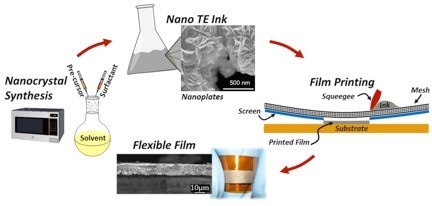Sep 21 2016
What if you could easily print a thin layer of material – for use anywhere – that would allow you to create flexible energy harvesters or coolers? That may soon be a reality.
 Boise State Research Explores Thermoelectric Screen Printing. (Boise State University)
Boise State Research Explores Thermoelectric Screen Printing. (Boise State University)
Thermoelectric conversion is a solid-state and environmentally friendly energy conversion technology with broad applications that include solid-state cooling, energy harvesting and waste heat recovery.
Flexible thermoelectric devices are especially attractive for waste heat recovery along contoured surfaces and for energy harvesting applications to power sensors, biomedical devices and wearable electronics – an area experiencing exponential growth. However, obtaining low-cost, flexible and efficient thermoelectric materials is extremely difficult due to many materials and manufacturing challenges.
In work led by professor Yanliang Zhang at Boise State University, high-performance and low-cost flexible thermoelectric films and devices were fabricated by an innovative screen-printing process that allows for direct conversion of nanocrystals into flexible thermoelectric devices.
The precise control of the starting nanocrystals’ shape and surface chemistry and the optimization of the nano-ink and screen-printing process are the key factors giving rise to unprecedented performances in the printed thermoelectric materials.
The paper on this work, “High-performance and flexible thermoelectric films by screen printing solution-processed nanoplate crystalsis,” is published on the Scientific Reports website. The collaboration with high-tech startup company ThermoAura, focusing on nanocrystal synthesis, also contributed to the success of this work.
Based on initial cost analysis, the screen-printed films can realize thermoelectric devices at 2-3 cents per watt, an order of magnitude lower than current state-of-the-art commercial devices. Such a cost reduction would make thermoelectrics a very competitive energy conversion technology that could tremendously open up the largely underexplored markets on waste heat recovery.
This additive printing method not only will benefit thermoelectrics, but also result in a disruptive manufacturing approach for other electronic devices and energy conversion or storage technologies of ultralow cost and flexibility.
Zhang’s vision on marrying additive manufacturing and advanced energy technology to enable major technology breakthroughs also has been recognized by a major federal funding agency. He recently received an infrastructure award from U.S. Department of Energy to invest an advanced additive printing equipment and establish state-of-the-art additive manufacturing capabilities at Boise State.
This new capability will enable students to perform cutting edge research on additive manufacturing and their applications on printing sensors, flexible electronics and energy conversion and storage systems.
More information: T. Varghese, et.al., High-performance and flexible thermoelectric films by screen printing solution-processed nanoplate crystals, Scientific Reports, 6, 33135, 2016.